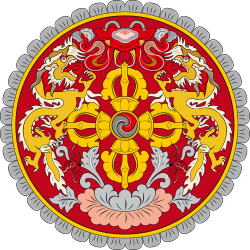National Assembly (Bhutan)
 From Wikipedia - Reading time: 9 min
From Wikipedia - Reading time: 9 min
27°29′23.2″N 89°38′17.5″E / 27.489778°N 89.638194°E
National Assembly རྒྱལ་ཡོངས་ཚོགས་འདུ་ Gyelyong Tshogdu | |
|---|---|
| 4th Legislature | |
 | |
| Type | |
| Type | of the Parliament of Bhutan |
| Leadership | |
Speaker | |
Deputy Speaker | Sangay Khandu, PDP since 25 January 2024 |
Leader of the Opposition | |
| Structure | |
| Seats | 47 |
 | |
Political groups | Government (30)
Opposition (17)
|
Length of term | 5 years |
| Elections | |
| Modified two-round system | |
First election | 24 March 2008 |
Last election | 30 November 2023 and 9 January 2024 |
| Meeting place | |
 | |
| Gyelyong Tshokhang, Thimphu (Here shown, Prime Minister Manmohan Singh of India addressing a joint session of the Parliament in 2008.) | |
| Website | |
| http://www.nab.gov.bt/ | |
| Constitution | |
| Constitution of Bhutan | |
 |
|---|
The National Assembly is the lower house of the bicameral Parliament of Bhutan, and it's responsible for enacting laws, representing the people, and overseeing the government. It consists of 47 members elected from 47 constituencies across the road country.
Under the 2008 Constitution, Article 12, section 1, the National Assembly consists of a maximum of 55 members directly elected by the citizens of constituencies within each Dzongkhag (District).[1] Under this single-winner voting system, each constituency is represented by a single National Assembly member; each of the 20 Dzongkhags must be represented by between 2–7 members. Constituencies are reapportioned every 10 years (Art. 12, § 2).[1] The National Assembly meets at least twice a year (Art. 12, § 5), and elects a Speaker and Deputy Speaker from among its members (Art. 12, § 3). Members and candidates are allowed to hold political party affiliation.
The 2013 National Assembly election resulted in large increase in percentage of PDP members, who held 32 seats to the DPT's 15 when the new assembly was convened.[2]
In the 2018 National Assembly election, PDP did not qualify for the elections. DNT saw a rise of 30 seats, thus becoming the majority party in the Assembly. DPT, which won 17 seats, became the opposition.
In the 2023–24 Bhutanese National Assembly election, both incumbent parliamentary parties failed to win seats. PDP returned as the majority party, while the new BTP became the opposition.
History
[edit]The National Assembly was originally decreed in 1953 by King Jigme Dorji Wangchuck. The National Assembly began as a unicameral parliament within the King's framework for democratization. In 1971, King Jigme Dorji empowered the National Assembly to remove him or any of his successors with a two-thirds majority. The procedure for abdication remains a part of Bhutan's Constitution of 2008, with the addition of a three-fourths majority in a joint sitting of Parliament (i.e., including the National Council) to confirm the involuntary abdication as well as a national referendum to finalize it.[1] (Art. 2)
Electoral system
[edit]The 47 members of the National Assembly are elected from single-member constituencies. Primary elections are held in which voters cast votes for parties. The top two parties are then able to field candidates in the main round of voting, in which members are elected using first-past-the-post voting.[3]
Speakers
[edit]Complete list of speakers of the National Assembly.[4]
| Name | Entered Office | Left Office |
|---|---|---|
| Dasho Kesang Dawa | 1953 | 1955 |
| Dasho Thinley Dorji | 1956 | 1963 |
| Dasho Tamji Jagar | 1964 | 1965 |
| Nidup Yanglop | 1966 | 1968 |
| Dasho Kesang Dawa | 1969 | 1971 |
| Dasho Shingkhar Lam | 1971 | 1974 |
| Nidup Yanglop | 1974 | 1977 |
| Dasho Tamji Jagar | 1977 | 1988 |
| Lyonpo Sangye Penjor | 1988 | 1989 |
| Dasho Passang Dorji | 1989 | 1997 |
| Lyonpo Kinzang Dorji | 1997 | 2000 |
| Dasho Ugyen Dorji | 2000 | 2007 |
| Lyonpo Jigme Tshultim | 2008 | 2013 |
| Lyonpo Jigme Zangpo | 2013 | 2018 |
| Lyonpo Wangchuk Namgyel | 2018 | 2024 |
| Lungten Dorji | 2024 | Incumbent |
Constituencies
[edit]
The National Assembly, the lower of the Parliament of Bhutan, consists Members of Parliament (MPs). Each MP represents a single geographic constituency.[5] Currently, there are 47 National Assembly constituencies.[6][7] Out of the 20 dzongkhags of Bhutan, Trashigang, with five constituencies, has the highest number of National Assembly constituencies. Samtse, with four constituencies, has the second highest number of National Assembly constituencies. Mongar and Pema Gatshel, with three constituencies each, share the third-highest position. All of the other 16 dzongkhags have two constituencies each.
See also
[edit]- Politics of Bhutan
- List of political parties in Bhutan
- Elections in Bhutan
- Parliament of Bhutan
- Bhutanese legislation
- List of constituencies of the Bhutan National Assembly
Notes
[edit]References
[edit]- ^ a b c "Constitution of the Kingdom of Bhutan (English)" (PDF). Government of Bhutan. 2008-07-18. Archived from the original (PDF) on 2011-07-06. Retrieved 2010-10-13.
- ^ "Bhutan's Election Commission completes polls process, hands over MP list to King". DNA India. 2013-07-14. Retrieved 14 July 2013.
- ^ Electoral system IPU
- ^ Past Speakers National Assembly of Bhutan.
- ^ "Election Act of the Kingdom of Bhutan 2008" (PDF). Government of Bhutan. 2008. Archived (PDF) from the original on 2018-09-21. Retrieved 2019-05-25.
- ^ "Final Delimitation Order For The National Assembly Constituencies Of The Kingdom Of Bhutan, 2017" (PDF). Election Commission of Bhutan. 2017-12-26. Archived from the original (PDF) on 2019-06-15.
- ^ "Constituency List". National Assembly of Bhutan. Archived from the original on 2019-04-02. Retrieved 2019-05-31.
External links
[edit]- "Official website of the National Assembly of Bhutan". Retrieved 2008-04-16.
 KSF
KSF